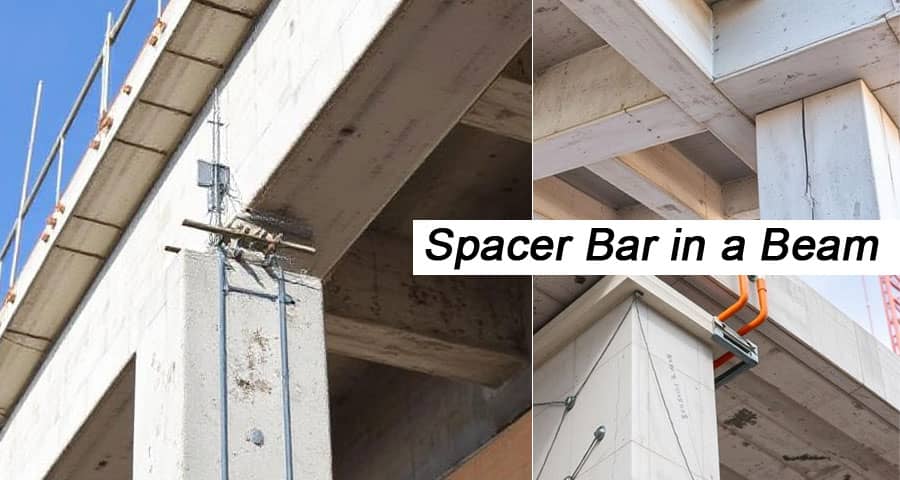What is a Spacer Bar in a Beam?

Introduction to Spacer Bars in Beams
In construction and structural engineering, precision and stability are essential for ensuring the integrity of any structure. One crucial component that plays a vital role in reinforced concrete beams is the spacer bar. These bars help in maintaining proper alignment and spacing between reinforcement bars (rebar) in beams, which in turn ensures adequate concrete cover and structural strength.
Definition and Purpose of Spacer Bars
A spacer bar in a beam is a structural element used to maintain the correct distance between reinforcement bars during the pouring of concrete. This ensures that the rebar does not shift or become misaligned, leading to uneven load distribution and structural weaknesses. The proper positioning of rebars is crucial for achieving the required load-bearing capacity and durability of the beam.
Key Functions of Spacer Bars in Beams
- Maintaining Uniform Reinforcement Spacing - Ensuring that rebars remain in their designated positions prevents weak zones in the concrete.
- Providing Adequate Concrete Cover - Proper spacing ensures that rebars are fully encased in concrete, protecting them from environmental factors such as corrosion and moisture.
- Enhancing Load Distribution - A well-placed reinforcement system ensures that the beam can withstand its intended loads efficiently.
- Reducing Construction Errors - By keeping rebars in place, spacer bars minimize errors in rebar placement, leading to consistent and reliable structural performance.
Types of Spacer Bars Used in Beams
Spacer bars come in various shapes, materials, and configurations to cater to different structural needs. The most common types include:
1. Steel Spacer Bars
Steel spacers are high-strength and durable components used in reinforced concrete construction. These are often used in large-scale projects where heavy reinforcement is required.
2. Plastic Spacer Bars
Plastic spacers are lightweight, cost-effective, and corrosion-resistant. They are commonly used in precast concrete applications and smaller construction projects.
3. Concrete Spacer Bars
Made from high-quality concrete, these spacers offer excellent compatibility with concrete structures, ensuring uniform expansion and contraction with the beam itself.
4. Composite Spacer Bars
Composite materials, such as fiber-reinforced plastics (FRP), offer high strength, corrosion resistance, and durability, making them an ideal choice for specialized applications.
Importance of Spacer Bars in Reinforced Concrete Beams
Ensuring Structural Integrity
The correct placement of reinforcement bars within a beam prevents weak points from forming in the structure, ensuring the beam performs as expected under different loading conditions.
Prevention of Corrosion and Durability Enhancement
By ensuring proper concrete cover, spacer bars help in preventing exposure of steel reinforcement to external elements, which could lead to corrosion and deterioration over time.
Compliance with Construction Standards
Structural codes such as ACI (American Concrete Institute), Eurocode, and IS (Indian Standards) mandate the use of appropriate spacers to achieve the necessary reinforcement clearances.
How to Choose the Right Spacer Bars for Your Project
Selecting the appropriate spacer bar depends on several factors:
1. Load Requirements
For heavily reinforced structures, steel or composite spacers are preferred due to their high load-bearing capacity.
2. Environmental Conditions
For corrosive environments (such as marine structures), plastic or composite spacers offer better longevity and resistance to moisture and chemicals.
3. Beam Dimensions and Rebar Placement
Different sizes and configurations of spacer bars are available to accommodate varying beam depths and reinforcement arrangements.
Installation and Placement of Spacer Bars in Beams
Step-by-Step Installation Process
- Plan the Rebar Layout - Ensure that reinforcement drawings specify the correct bar spacing.
- Select the Appropriate Spacer Bars - Choose based on load, environmental conditions, and beam dimensions.
- Position the Spacer Bars Correctly - Place them at required intervals along the length of the beam.
- Secure the Spacer Bars - Fasten them to the rebar using binding wires or clips to prevent movement.
- Check the Alignment - Before pouring concrete, verify the alignment of the rebar and ensure all spacers are securely in place.
- Concrete Pouring and Curing - After installation, carefully pour the concrete and allow it to cure as per engineering specifications.
Common Mistakes to Avoid When Using Spacer Bars
1. Using Inadequate or Weak Spacers
Using low-quality or insufficient spacers can result in improper rebar positioning, affecting the overall strength of the beam.
2. Incorrect Placement of Spacer Bars
Misaligned spacers can cause uneven concrete cover, leading to potential structural issues.
3. Failure to Secure Spacer Bars
If spacers are not properly fastened, they may shift during concrete pouring, compromising structural integrity.
4. Neglecting Environmental Factors
Using metal spacers in a highly corrosive environment without protective coatings can lead to premature deterioration of the reinforcement system.
Conclusion
Spacer bars are an essential component in reinforced concrete beams, ensuring proper alignment, durability, and load distribution. By selecting the right type of spacer bar and following proper installation practices, engineers and builders can ensure the structural integrity and longevity of concrete beams.
Please watch the following short video for spacer bar in a Beam
